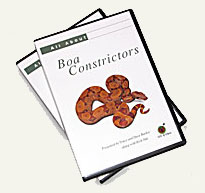Juvenile Sumatran short-tailed python is a poor feeder...
Dear VPI,
Let me preface this by saying that I already talked to the dealer from whom I purchased this snake and received no helpful information or assistance, so I am turning to you for advice.
I purchased a Sumatran blood python approx. 11" in length, and took it home to a cage (Tupperware plastic shoebox) already set up, measuring 9"x14"x4.5" tall. In the cage the substrate is newspaper, there is a hide-box water and moss-box. Temperature is on a thermostat which I also monitor with a thermometer, and is heated with a ceramic heat lamp above the cage and a heat pad under one side for the warmer area. The temp is 80 on the cool side and 85-86 on the warm side. I left the snake alone for the first week and then offered it a f/t [frozen/thawed] mouse which it ate. A week later I offered it another f/t mouse which it declined; the following day I offered a live one which it ate. The next week it accepted a f/t mouse and defecated, the following week it would only take a live one. That was the last time it ate, which was two months ago.
I have offered it food live or dead, sometimes rat pups on a weekly basis since then. I never hit the snake with the food item or anything like that, on occasion when the rat pup crawled into the opening of the hide-box and touched the snakes nose it acted very scared and shied away. The snake never leaves its hide-box that I have seen and sometimes I take it out and place it in its water bowl and sometimes it drinks then. I don't think that it is dehydrated. When I place the food in the cage it flicks its tongue for a minute but that's it. Most of the time it just sits there with its head looking out of the hide box. I tried raising the temp 4 degrees for about 2.5 weeks but that didn't make a difference and I have since lowered it back to the original temps of 80/85. Its light cycle is the same as it is outside right now, so I was wondering if that could be the problem? The snake doesn't seem to be losing much weight. I was also wondering if it would be ok to use only under-cage heating; the cage is not in a rack system or anything like that.
thank you very much,
jeff
Dear jeff,
Your snake may be too warm, or it may be that it is influenced by the short winter days.
Regarding the warm possibility: we keep all baby bloods and short-tails in cages that are similar to what you describe in a room that is 78-82 degrees (night/day). We give them no supplemental heat and they do not appear to require it.
When we have tried to provide supplemental heat by sitting them on a heat tape or thermofilm (FlexWatt) they quit eating because it's too warm. The problem is that the air is warmed by the heated floor and even though on the other end of the cage the floor temp is cooler, the air throughout the cage is too warm and that warms the snake.
It's a common misconception among keepers with little actual experience with bloods and short-tailed pythons that they require fairly warm conditions to be happy and many keepers keep them too warm. In fact, blood pythons and their relatives are inactive dwellers of the cool forest floor and they prefer to be cooler than many pythons.
Our cages are smaller and we do not provide the amenities that you give your snake. Ours have only newspaper and a water bowl--no more. The cages (4" x 14" x 3") are placed on a shelf rack, so that the back of the cages are in the dark. Placed in larger cages, young bloods and short-tails often won't feed. The fact that you have provided a hide box has probably made the difference for your snake. The issue for baby snakes is "security." If they feel secure in their cage, then they feed--if they are insecure, they do not feed.
Regarding the seasonal causes of fasting: it's common that adults fast in the winter. It's not common that youngsters quit feeding in the winter, but it happens. It's hard to change this around, they are strongly influenced by day length and light from windows sets their internal clocks more than anything you can easily do with artificial lights. The bottom line is that if your snake is winter fasting, it probably will resume eating in late February or thereabouts.
Tracy's and my general policy for a snake that was feeding and quit--if it looks and acts healthy and it has no problems that we're aware of, we leave it alone.
Force-feeding is probably not a good option. Happy and healthy snakes eat, unhappy or unhealthy snakes don't eat-force-feeding doesn't solve those problems. More times than not, force-feeding a snake just adds to the problems.
Good luck with this baby. DGB
